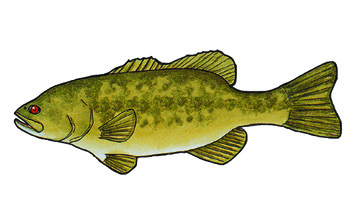

They were found in southeastern Canada, throughout the eastern United States into Mexico, but have been successfully introduced into freshwater habitats throughout the globe.
They live in freshwater ponds, lakes, rivers and streams in shallow, calm, clear waters where plants grow as shelter.
They can grow large reaching more than 20 pounds with females growing larger than males. They have a darker stripe down their sides and a double humped back (dorsal) fin (see picture).
They are more active in the cool mornings and evenings.
They eat water insects, crayfish, other fish and any other small animals in the water (like the larvae of dragonflies and other insects).
Females lay eggs once every spring when the water is warm enough – about 60°F. Males build a small dent in the sand in shallow water to attract a female. Females lay thousands of eggs in the “nest” of their choice. The hatchlings are guarded by the male for their first month.
Kingdom: Animalia
Phylum: Chordata
Subphylum: Vertebrata
Class: Actinopterygii
Order: Perciformes
Suborder: Percoidei
Family: Centrarchidae
Genus: Micropterus
Species: M. salmoides
When you research information you must cite the reference. Citing for websites is different from citing from books, magazines and periodicals. The style of citing shown here is from the MLA Style Citations (Modern Language Association).
When citing a WEBSITE the general format is as follows.
Author Last Name, First Name(s). "Title: Subtitle of Part of Web Page, if appropriate." Title: Subtitle: Section of Page if appropriate. Sponsoring/Publishing Agency, If Given. Additional significant descriptive information. Date of Electronic Publication or other Date, such as Last Updated. Day Month Year of access < URL >.
Amsel, Sheri. "Bass (Largemouth)" Exploring Nature Educational Resource ©2005-2024. December 13, 2024
< http://www.exploringnature.org/db/view/Bass-Largemouth >

